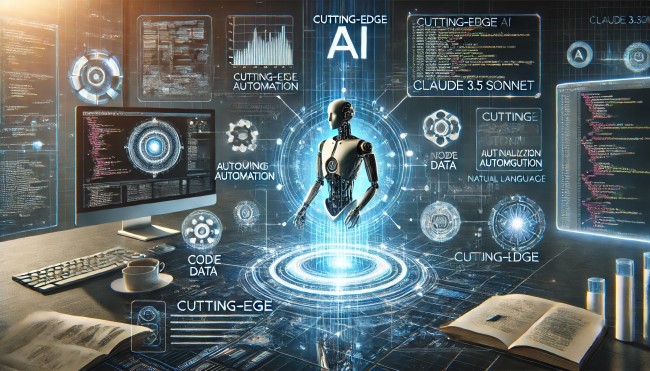Claude 3.5 Sonnet: A Leap Forward in Autonomous AI Capabilities

In the rapidly evolving AI landscape, Claude 3.5 Sonnet has emerged as a standout model, designed to push the boundaries of natural language processing, autonomous computer interaction, and dynamic content creation. Developed by Anthropic, this model represents a significant leap forward in how AI can support complex workflows, facilitate code generation, and enhance customer support interactions.
Anthropic’s Claude 3.5 model family includes various versions tailored to different applications: Claude 3.5 Sonnet, Claude 3.5 Opus, and Claude 3.5 Haiku. Each variant offers unique features that address specific user needs, from speed and affordability to computational robustness and high-level reasoning. This article dives deep into Claude 3.5 Sonnet’s features, capabilities, and comparisons with leading AI models, such as OpenAI’s GPT-4o, making it an essential read for businesses and developers seeking cutting-edge AI solutions.
Understanding the Claude 3.5 Model Family
Anthropic has crafted a series of models within the Claude 3.5 lineup, each offering a unique mix of performance, affordability, and speed to cater to a wide range of users:
- Claude 3.5 Sonnet: This is the flagship model in the Claude 3.5 series, featuring advanced capabilities in natural language processing and enhanced “computer use” functions, allowing it to perform tasks autonomously on a computer interface.
- Claude 3.5 Opus: As a step up from previous models, Claude 3.5 Opus is built for complex tasks requiring multi-step instructions and detailed responses, making it ideal for applications in data analysis, content creation, and customer service.
- Claude 3.5 Haiku: The lightweight version of Claude 3.5, Haiku is tailored for affordability and speed, excelling in quick responses and lower latency tasks suitable for user-facing applications that require rapid turnaround.
Claude 3.5 Sonnet: A Deep Dive into Features and Capabilities
Claude 3.5 Sonnet is equipped with state-of-the-art capabilities that set it apart from its predecessors and many other AI models on the market:
- Enhanced Natural Language Understanding: Claude 3.5 Sonnet has been optimized to understand and process complex language inputs. This model excels at interpreting nuance, humor, and multi-step instructions, making it particularly suitable for tasks that require a conversational and human-like tone.
- “Computer Use” Capability: One of the most exciting features of Claude 3.5 Sonnet is its “computer use” functionality, which allows it to autonomously interact with software and online interfaces. This means it can perform tasks like navigating applications, filling forms, and executing commands on behalf of users.
- Benchmark Performance: On various industry-standard benchmarks, Claude 3.5 Sonnet has outperformed previous versions and some competing models. It excels in coding accuracy, task completion, and complex reasoning, scoring notably high on the SWE-bench and TAU-bench for coding tasks.
- Artifact Generation: Users can now create “artifacts,” or dynamic workspaces, that enable real-time interaction with Claude’s output. This feature is especially useful for developers who require iterative refinement, such as generating, editing, and deploying code or content.
The Claude 3.5 Sonnet API: Unlocking Potential for Developers
The Claude 3.5 Sonnet API offers developers direct access to its robust set of features, allowing integration into custom applications and workflows. The API’s versatility in adapting to various programming languages and handling complex tasks makes it a valuable tool for enterprises seeking to optimize internal processes. Key benefits of the Claude 3.5 Sonnet API include:
- Seamless Integration: Available on Anthropic’s API, as well as platforms like Amazon Bedrock and Google Cloud’s Vertex AI, the API provides a smooth integration experience.
- High-Performance Parameters: With millions of parameters fine-tuned for precision, the Claude 3.5 Sonnet API performs exceptionally in tasks such as automated customer support, software debugging, and content generation.
- Enhanced Security and Safety: Claude 3.5 Sonnet has been tested rigorously to ensure secure deployment, especially for applications where privacy and ethical considerations are paramount.
Comparing Claude 3.5 Sonnet and GPT-4o: A Look at Key Differences
Anthropic’s Claude 3.5 Sonnet and OpenAI’s GPT-4o are both advanced AI models, yet they serve distinct purposes and offer unique advantages. Here’s how they stack up:
- Coding and Debugging Capabilities: While GPT-4o is known for its language generation strength, Claude 3.5 Sonnet has been optimized for coding accuracy and performance, scoring higher on specific coding benchmarks like SWE-bench.
- Task Automation: With its “computer use” feature, Claude 3.5 Sonnet can autonomously execute commands on software interfaces, a capability GPT-4o currently lacks. This makes Claude 3.5 Sonnet more versatile for businesses that require AI to handle routine or repetitive tasks.
- Language and Contextual Understanding: Both models are proficient in language processing, but Claude 3.5 Sonnet’s training on humor, context, and nuanced language gives it a slight edge in applications requiring a conversational tone.
- Processing Speed and Cost Efficiency: Claude 3.5 Sonnet operates at a faster speed compared to GPT-4o and is priced to make high-level AI accessible for a broader audience.
Claude 3.5 vs. GPT-4o: Performance Comparison and Benchmarks
When comparing Claude 3.5 Sonnet with GPT-4o, several benchmarks highlight the strengths and weaknesses of each model. Claude 3.5 Sonnet has shown superior performance in agent-based coding tasks and tool-use evaluations, essential for users seeking reliable coding assistance or automated software testing. However, GPT-4o remains competitive in general-purpose language processing and creative content generation, giving it an edge for less technical applications.
Claude 3.5 Opus: Where It Excels
Claude 3.5 Opus, another variant in the Claude 3.5 family, is a powerhouse model designed to handle data-intensive tasks. Opus excels in scenarios requiring multi-step reasoning and detailed responses, such as customer support automation, workflow optimization, and data analysis. Businesses that rely heavily on structured data or need AI support in regulated environments may find Claude 3.5 Opus the most suitable choice due to its reliability and robustness.
Claude 3.5 Sonnet Parameters: Built for Precision and Performance
Claude 3.5 Sonnet’s parameters are fine-tuned to maximize precision, making it capable of handling complex instructions with high accuracy. The model’s enhanced architecture supports a large number of parameters, allowing it to achieve high benchmark scores across different domains, from coding and debugging to natural language understanding and task automation.
ChatGPT-4o vs. Claude 3.5 Sonnet: Which AI Model Is Right for You?
In the ChatGPT-4o vs. Claude 3.5 Sonnet debate, the decision largely depends on specific needs:
- For Technical Tasks: Claude 3.5 Sonnet has a clear advantage in coding and task automation due to its strong performance in tool-use benchmarks and coding evaluations.
- For Language Generation: ChatGPT-4o remains a strong choice for creative and general-purpose language tasks. Its conversational abilities are comparable to Claude 3.5 Sonnet but may lack the latter’s task automation features.
- Cost Efficiency: This technology is designed to offer more cost-effective solutions for high-level tasks, making it ideal for businesses looking to integrate AI on a budget.
The Future of AI with Anthropic Claude 3.5
This technology has set a new standard for what conversational AI can achieve, especially with the addition of autonomous task-handling capabilities. As Anthropic continues to refine and expand its Claude model lineup, future iterations promise to offer even more capabilities in areas such as multi-modal inputs (image, text, and video), memory functions, and personalized experience building. The integration of Claude 3.5 Sonnet into platforms like Amazon Bedrock and Google Cloud’s Vertex AI also suggests wider adoption in enterprise solutions and custom applications.
With its robust API, high-performance parameters, and diverse model family, Claude 3.5 is positioned to reshape the AI landscape, offering solutions for developers, businesses, and end-users alike.



